The Adventure:
On July 16 – 22, 2007, Bill and I went on a 7-day, 60-mile Sierra Nevada backpacking trek on the High Sierra Camp Loop trail.
We started at the Tuolumne Meadows Lodge and made our way through five camps spaced about 6-10 miles apart:
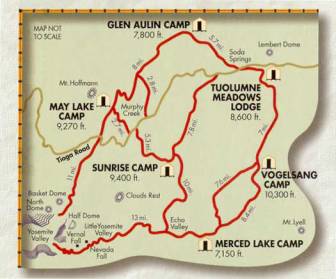 |
Glen Aulin (est. 1927)
May Lake (est. 1938)
Sunrise (est. 1961)
Merced Lake (est. 1916)
Vogelsang (est. 1924)
|
The camps were a wonderful haven after a tough day of hiking. They had canvas cabins (with beds), dining halls, restrooms and most have showers. Best yet, they serve huge, delicious dinners and breakfasts and make big sack lunches for you to take on the trail.
Our Guide:
| We went on a Ranger-lead hike with Adrianna Hirtler as our leader. She loved Yosemite and was eager to share her knowledge and passion with us. She bounded over boulders like a gazelle, filtered our water, nursed our blisters, brewed tea from native plants for us to drink and taught us so much about the place. She knew everything – the history, plants, animals, stars, geology, and she even knew about the fungi beneath the soil. We were very lucky to have Ranger Adrianna guide our way. |
 |
Dispenses knowledge
Pigtails in a ranger hat
Shares her world with us
NOTE: The above passage is a Haiku poem I wrote on the trip. I have several others interspersed from the collection called “Hiking Haiku.”
For this adventure I decided to leave my heavy camera at home. It was too bulky to manage and I wanted to see the amazing panoramic vistas rather than spending time framing pictures and seeing images through a small viewfinder. (Most of the photos are Bill’s with a few contributions from Fred and Norma from the group.) It was a great gift to be free of the camera for a week. Instead of obsessing about getting the perfect picture, I studied nature taking only mental notes and then writing haiku versus at the end of the day.
Left my camera home
Only have my eyes’ lenses
To record nature
Our Group:
San Diego Group
- Norma – A lovely lady with a million dollar smile who was always taking care of us; a tough grandma and loving wife to Pete.
- Pete – Charming, knows no stranger, fun to be around and adores his wonderful mate,
Norma.
- Fred – Tough hiker, friendly good guy, retired engineer, added lots of good facts.
- Ron – Wise, quiet lawyer with a gift of storytelling and a great sense of humor.
- Steve – Our buddy from San Diego – a real team player and a joy to share any adventure with – We’d been on several trips with Steve.
- Bill – Tough and wiry -- great guy to have along – I love him because we’ve been married for over 40 years and he still helped me put my backpack on.
- Nancy (that’s me) – loved the adventure, loved my fellow trekkers and loved learning all about the place from Adrianna.

Some of the S.D. hikers – Norma, Bill, Fred, me and Steve |

Nancy – outside the first tent camp at Tuolumne Meadows – ready to start the trek |
The Weiner Gang (by the way, they never whined)
- Karin Weiner – lives in L.A. Young lawyer bubbling with smarts and personality She was on the trek with her father.
- Mike Weiner, also from L.A. – Karin’s Dad, quiet, liked to fish and loved to be with his beautiful daughter, Karin.
- Walt Davie – the character of the group – 75, the original “Wild Man” with a mind filled with obscure songs that made us laugh. Mike and Walt are friends.
- Scott (from St. Paul) – Walt’s son, witty and tough and very proud of his Dad. A week before the trek, Scott was run over by a truck while on a bike ride. In spite of his injuries (oozing, open wounds), he bounded over the mountains with ease.
NOTE: Karin and Scott did this hike with their parents, Mike and Walt, several times when they were growing up. Their last family trek was when they were 16. Now in their 30’s, they had a lot of catching up to do.
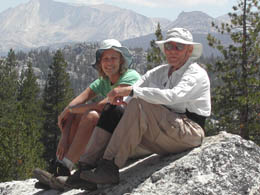
Karin and Mike |
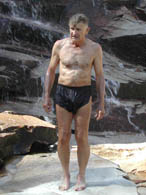
Walt |

Scott |
The Girls (Pals traveling together – We affectionately called them “The Girls)
- Anne (from Sacramento) – Art teacher, quiet and gentle, and tough. Got the flu on the second day, went back to Tuolumne Meadows (with her friend Grace) to recover and then re-joined the group.
- Grace (from Yuba City) – Veterinarian and Anne’s friend, lovely person, stayed with her friend during her illness and then re-joined the group.

Anne and Grace - The Girls |
NOTE: On the first day of the trek, we were missing three hikers from the San Diego group. Dick, the one who won the lottery and the right to be on the trek, tripped and fell on a trail the day before and broke his leg. Pete and Ron decided to help get him from the Mammoth Hospital back to San Diego. On the first day of hiking, they chose to drive Dick to Ridgecrest to hook up with someone else coming from San Diego to exchange the body, then returned to the trek, joining us later that evening.
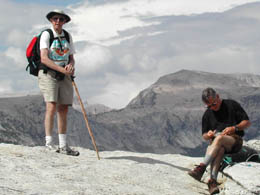
Dick, standing, shortly before he broke his leg (Ron is sitting) |
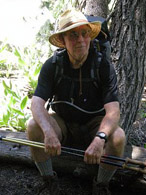
Ron taking a break (oops – bad choice of words) |
Day 1
Monday, July 16, 2007
Tuolumne Meadows Lodge (8700 feet ) to Glen Aulin Camp (7900 feet)
6.7 miles / 800 feet elevation loss
At 9:00 am, we met Adrianna and our group at the lodge in Tuolumne Meadows. After adjusting our backpacks, we hit the trail at 9:30. Even though it was an easy day, losing 800 feet in elevation, those of us who live at sea level were still acclimating to the high altitude and trudging along rather slowly.
Adrianna kept the group together, stopping and pointing out several interesting things along the way.
Our first bit of excitement was a very mellow yellow-bellied marmot relaxing on a rock. They are rodents commonly seen along trails. This one didn’t even flinch when we walked by. They’re pretty gutsy - peeing and pooping right on the rocks where they lay, not a bit worried that their predators will follow the smell and find them.

Yellow-Bellied Marmot |
Adrianna showed us one of the several Yosemite weather stations with a “snow pillow” used to measure the snowfall. This year Yosemite only got 30% of its average snow pack – not good.

Adrianna and the snow pillow |
We stopped at Lembert Dome – a huge rock structure and a good example of “Roche Moutonnee” (French for sheep rock). These asymmetrical outcroppings of rock resemble sheep feeding in a meadow. The gentle, sloping ridge follows the direction from which the glacier came as it rode up and over the rock.

Lembert Dome |
Some smooth rounded holes were carved into the rock on the granite base of Lembert Dome. These were the first food processors that Indians used for processing black oak acorns, pine nuts, corn and other things. (I’ve heard them called “grinding holes,” but Adrianna said they used a stone to “pound” the nutmeats, not “grind” them. Grinding adds some chipped stone to the mill, not a good thing for one’s teeth.)
| A Little History American Indians inhabited this region as long as 4,000 years ago. When the “white man” came to Yosemite in the mid-19th century, they entered the homes of the Southern Sierra Miwok. The Miwok called their valley "Ahwahnee" - valley that looks like a gaping mouth and called themselves Ahwahneechee, dwellers of that valley. They harvested black oak acorns, hunted and fished and traded these and other items with the Mono Lake Paiute people for rabbit skins, pine nuts, insect foods and obsidian (sharp black rock used to make arrow heads and operating instruments). The tribes would meet once a year to smoke a peace pipe and trade their goods.
Before 1851, few non-Indians knew about Yosemite Valley. In 1848, James Marshall discovered gold in the Sierra foothills and triggered the gold-rush that changed the future of California’s Indians forever. Thousands of gold seekers rushed into the territory. They stole the Indian land and murdered the native people. The territory became a state, cities sprang up, roads were built, and rivers dammed.
NOTE: Bennettville, just outside Yosemite National Park, was established as a sliver mining town from the late 1870’s to 1883. It was financed by money back east with dreams of accommodating 50,000 people. Part of the “urban development” plan was to link a road from Lundy to Bennettville but it was never finished due to the harsh winter that hit during the construction. (Chinese workers provided a large part of the labor.) Now Bennettville is a ghost town with a few cabins and a bunkhouse left as reminders of a time gone by.
Once the white invaders discovered gold in the mountains, life was forever changed for the native people. Conflicts arose between the Indians and the miners. Finally, the Indians were fed up and started the “Mariposa Indian War.” They attacked the white residents of Mariposa, a mining town southwest of Yosemite. There were other raids on villages where white settlers were murdered. The white man retaliated with attacks on the tribes. They burned the native Indian’s acorn granaries and other food storage areas as well. On March 27, 1851, to end “this problem with the Indians,” the Mariposa Battalion entered Yosemite Valley (under the authority of California Governor McDougal). The Battalion became the first group of non-Indians to record their entry into the Valley.
The Battalion followed the Indians into the mountains and then into the Valley, where the Miwoks and their chief, Tenaya, were captured and relocated in the Fresno River Reservation. A couple of years later, some of the Miwoks, including Chief Tenaya, were allowed to return to their Valley.
Chief Tenaya was a legend in his own time. He refused to sign any white man’s treaties. He was brave and managed to escape the white man’s clutches several times. He lost his desire to keep up the chase after the White man killed his son. Finally, Chief Tenaya was killed in 1853 and the Miwoks scattered throughout the Sierra, never again unified as a tribe. His death ended the hope for native people in the area to ever have their land back and live in harmony with nature. In spite of his troubles, Chief Tenaya was respected by both the White man and the Indian people. The name of “The Lake of the Shining Rocks” was changed to “Lake Tenaya” to honor him, even though Tenaya didn’t believe lakes or mountains should be named after people.
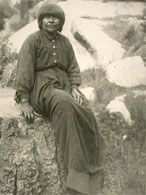
Indian woman (Yosemite area)
The Bancroft Library. University of California, Berkeley |
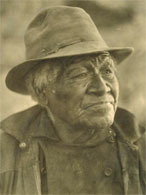 Paul, for years known as the best Indian guide in the Yosemite Valley High Sierras - Boysen Photo The Bancroft Library. University of California, Berkeley Paul, for years known as the best Indian guide in the Yosemite Valley High Sierras - Boysen Photo The Bancroft Library. University of California, Berkeley |
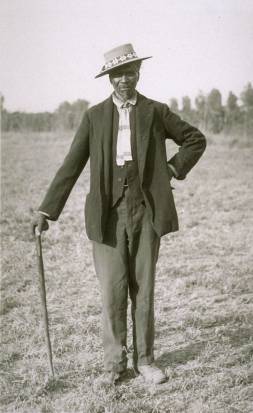 Clovis - Bill Wilson, Sept. 19, 1915 Clovis - Bill Wilson, Sept. 19, 1915
The Bancroft Library. University of California, Berkeley |

Indian mother and baby (Yosemite area)
The Bancroft Library. University of California, Berkeley |
After the “problem with the Indians” was taken care of, the first tourists arrived in 1855. The San Francisco newspaper reported on Yosemite's wonders. Within a few decades after the gold rush, tourists came pouring into Yosemite Valley. Roads were built, supply routes established, and hotels developed. White establishments were constructed on or near native villages, which meant the native people had to live in more marginal locations. Indians starved to death as their traditional food supply was cut off. Domestic livestock ate the acorn supply. Forests were decimated. Miners and ranchers diverted river channels that once contained foodstuffs, medicines, and building materials for the Indians. Welcome to civilization.
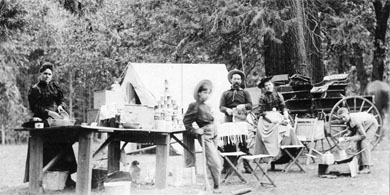
Camping in Yosemite Valley, 1906
San Joaquin Valley Library System |
|
Adrianna pointed out that the valley was a rich homeland to the Indians for hundreds of years. Nature provided them with a full supermarket of goods. Miners came with their eyes focused only on gold. Instead of abundance, the miners saw scruffy bushes and boulders and other annoyances.
Miners’ barrier
Indians’ fruitful homeland
Hikers’ get away
We stopped by Soda Springs and tasted the bubbly mineral water. For thousands of years animals and people have come to these springs. Deer and birds get their minerals here. The small, carbonated mineral springs are a mystery – no one can explain why they exist here.
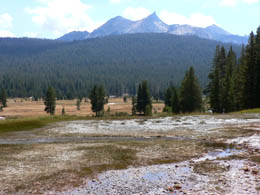
Soda Springs |
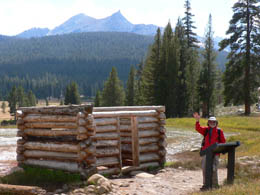
Bill at Soda Springs |

Adrianna scooping up
mineral water for us |
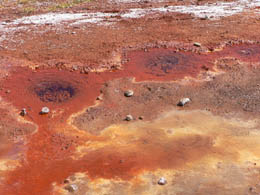
Soda Springs |
A wacko French guy named Jean Baptiste Lembert came to the Soda Springs area in 1872 to homestead. He raised Angora goats in this beautiful valley and called himself the “King of Tuolumne Meadows.” He fell in love with a gal in town named Nellie. He called her the “Queen of Tuolumne Meadows.” She had no interest in him, so he just stalked her until his weird mind decided he wasn’t in love anymore. He saw a rock structure that looked like a chicken and named it after her because he thought she hen pecked him. (Poor Nellie – may you rest in peace.)
Past Soda Springs, we hiked on a flat trail close to the Tuolumne River with views of the Cathedral Range. Adrianna also pointed out Unicorn Peak and Fair View Dome. She quizzed us on these mountain ranges several times. She really wanted us to learn something on our trek.
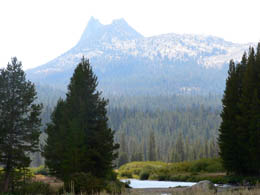
View of Cathedral Peak |
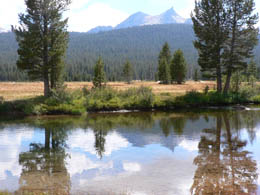
View of Unicorn Peak |
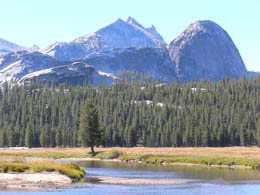
View of Fair View Dome on right |

Tuolumne River |
Adrianna found a lovely place to lunch down by the Tuolumne River.
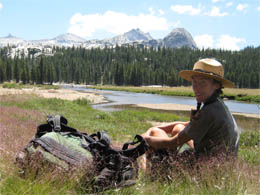
Adrianna |

Nancy |

Steve |

The Weiner Group |
A little farther down the trail we found ourselves in “granite world” -- a huge slab of polished granite at the bottom of a dome near the river. I felt like we were standing in a giant bowl. The glaciers polished the shiny, flat surface of these rocks centuries ago. I have to admit I’m not a rock person – but it was comforting to be surrounded by so much hard stuff.
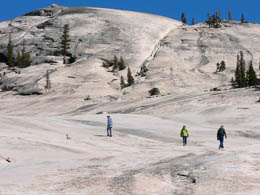
“Granite World” |

Resting on the way to Glen Aulin |
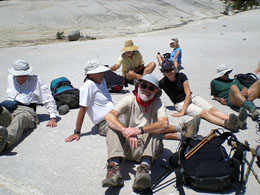
Bill and the Gang |
We relaxed on the warm rocks while Adrianna introduced us to the geology of the park -- metamorphic and sedimentary rocks versus igneous rocks. I was overwhelmed by her knowledge -- granite, glaciers moving and carving rocks. There were old rocks (red with iron) piled up on Dana Mountain 200 million years ago verses granite, the new guy on the block, some 20 million years ago. We looked up into the mountain ranges and saw the birthplace of a glacier. I asked Adrianna if she studied geology in school. She answered, “No, I just like to learn about it ” and then she added, “Sometimes academia takes the passion out of things.” Sounded like John Muir and his quest for learning in a “university without walls.”
A glacier is born
Ice built up and moving out
Deep cavernous womb
Batter down the bowl
Lava, molten rock, granite
The Devil’s swirl cake
Farther down on the trail, we entered a canyon and then climbed along the edge of the cliff. Soon the trail descended along a cascading river with some really nice views. We stopped to rest by some lovely cascades along the final stretch toward Glen Aulin. It was a glorious afternoon. I laid on the warm rocks and dangled my feet in the water.
Laying belly down
On a warm sun-washed boulder
I am a lizard
Cascading currents
Running swiftly on my feet
Nature’s healing Spa
Soft warm gentle breeze
Embraces, caresses, and
Whispers in my ear
Clouds over the sun
The Earth quiets, dims and chills
God, open the drapes

Falls on Tuolumne River |
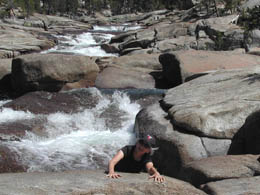
Is Nancy in Trouble? |

Cascades on Tuolumne River |

Nancy enjoying a rest |
We put our boots back on and picked up our backpacks and then continued our descent down the trail. About 5:30 pm, we crossed a bridge and there we were -- at Tuolumne Falls right next to our camp -- Glen Aulin.
The friendly guy at the check-in desk offered us lemonade and leftover goodies (cakes and French toast). They assigned the four gals, Norma, Anne, Grace and me, to a cabin and the guys to another cabin. Anne is having some trouble with her back – mattresses are lousy and the backpack isn’t helping.
I unpacked all the little zip lock bags in my backpack. It was very confusing at first trying to figure out what you need and what goes into the bear box. After getting organized, I went down to the waterfall and pool, just a stone’s throw from our tent. The water was cold. I didn’t want to go in, but I had to because there were no showers in the camp. I made myself plunge under the water to wash off the day’s sweat and dirt. It was refreshing, but what a sad, pitiful sight to see me hopping around those rocks in that cold water.

Glen Aulin High Sierra Camp |

Tuolumne Falls |

Nice dip after a long hike |

Norma |
After my dip, I went back to the cabin to add more layers of clothing for warmth. I heard the 6 o’clock call for coffee or tea and then at 6:30, we all went into the dining hall for dinner. We sat with Adrianna, Norma, and Steve and consumed massive amounts of bean soup, cornbread, Southwestern chicken, rice, squash, and chocolate cake with cherry sauce. The food was to die for. Afterwards, the staff (cooks, servers, etc.) introduced themselves (a clever ploy for tips). We loved their cute, laid back personalities. My favorite was Katie from Kansas.

Glen Aulin Dining Hall |

Dinner at Glen Aulin--Adrianna, Norma, Bill, Nancy and Steve |
After dinner, we watched the sunset (8:19 p.m.) overlooking the “Grand Canyon of Tuolumne” and Mt. Conness (12,590 feet). Mt. Conness was named after California Senator Conness who convinced President Lincoln in 1864 to sign the Yosemite Grant and establish the country’s first public preserve. This land grant set a new precedent for other national and state parks that were later established. The grant deeded only Yosemite Valley and the Mariposa Grove of Giant Sequoias to the state of California.
NOTE: Because the idea of preserving parkland started here, the Sequoia pinecone is displayed on all National Park Service Ranger hats and belts. Yellowstone was actually the first official national park.
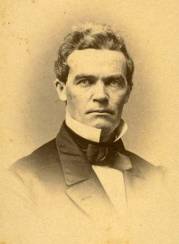
Hon. John Conness, Cal., 1864.
Silas Selleck, photographer. The Bancroft Library. University of California, Berkeley |
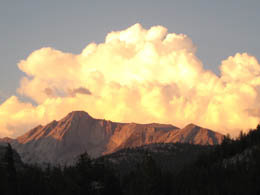
Mt. Conness |
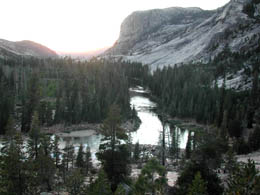
Sunset Over the Grand Canyon of the Tuolumne |
Bellowing white clouds
Trapped behind the mountain ridge
Towers of whipped cream
Sunset on a ridge
Mountain ranges all ablaze
Darkness ends the show
After our amazing sunset, Pete and Ron came running up the trail into camp. THEY MADE IT! They had delivered Dick with the broken leg half way to San Diego and then returned to race down the trail in a record three hours to join us. They hiked like crazy to get to the camp before sunset. They were our returning heroes and we were all thrilled, especially Norma, to see them.
At 9:00 pm, Adrianna conducted the first of many informative campfire talks. First we sang Clementine (including every verse ever written or imagined). Adrianna likes to sing. Then she poured out fact after fact on the subject of “Water and Fire.” By the way, our campfire kept going out. I don’t think we did anything to upset Vulcan, the god of fire.
Following are some miscellaneous notes from the campfire.
- Water has social properties making it cling together.
- The world is 65% water; man is also 65% water, but the brain is 95% water.
- We sweat. Sweat evaporates and feeds the trees. (We are all connected – all “hitched” together like John Muir says.)
- A Giant Sequoia consumes 4,000 gallons of water a day.
- Hetch Hetchy was once a beautiful valley, maybe even more beautiful than Yosemite Valley. That all changed when Congress (with the approval of President Woodrow Wilson) passed the Raker Act in 1913 to build O’Shaughnessy Dam and flood the valley so that the citizens of San Francisco could have the water. (The earthquake of 1906 contributed to this sad decision.)
- The Owens Valley (in the Owens Water Basin) on the east side of the Sierras was a lush farmland. Years ago, when L.A. was just a small town, the mayor of L.A. was on a trip to Yosemite and noticed all the water in the Owens Valley. He wanted growth for his fine city and needed lots of water to make that happen. He returned to L.A. and, with the help of William Mulholland, the Director of the L.A. Department of Water and Power, started the project to build a 250-mile pipeline to L.A. and taking (or was it stealing?) the water. (The movie, “Chinatown” is about the corruption and deal making that fed “desert-like” L.A. the water required for its tremendous growth.)
Adrianna always ended with a John Muir quote or passage. Tonight she read “Snow melts into music” from Muir’s journal.
We went back to our tents. I stayed up late writing my observations in Haiku verse. I decided to call my little gems “Hiking Haiku.” I’m inspired and addicted to making up these little blips, tapping out 5 / 7 / 5 line syllables.
Day 2
Tuesday, July 17, 2007
Glen Aulin to May Lake
8 miles / 1,500 feet elevation gain
Up at 6:30 to gather our bear box items and pack up our backpacks. What a pain organizing and stuffing everything back into my maroon backpack.
The call for coffee and tea was right on time at 7:00 am, followed by breakfast at 7:30. And what a breakfast it was -- oatmeal, fruit, yogurt, bacon, scrambled eggs with mushrooms and cheese, and blueberry pancakes. Thought we could never stuff it all down, but at the end of the trip, we came to expect such massive quantities of food.
At 8:45, we gathered to sing a good-bye song to the Gen Aulin staff. Walt, who has a gift for music – bizarre music, became our designated composer and song leader for the trip.

Walt, song leader |
Glen Aulin Farewell Song -- by Walt Davie
Goodbye to you, goodbye to me,
The yonder trail is callin'
The packs are packed and the boots are laced,
'Tis the leavin' of Glen Aulin
Goodbye to you, goodbye to me,
We can no longer stay
We're bound for Volgelsang, me boys, it's fifty miles away
|

Bill, ready for another day of hiking |

Fred wants to get on the trail |
Yesterday was the easiest hike, but today is a full day of hard hiking with a taste of the mountains. Adrianna bounded over the hills and then stopped to share her knowledge of this amazing place.
We stopped in a pine forest. Adrianna showed us how to identify the Lodgepole and whitebark pines found at the higher elevations. Lodgepole pines, the most widely distributed pine in North America, have yellow-orange bark and small cones and needles in bundles of two, attached to the branch in a brush like fashion. Whitebark pines five needles bunched together. We saw so many Lodgepole Pines that day in the meadows, on the slopes and ridges. (Adarianna gave us the brain teaser “Why are Lodgepole pines twisted? There’s really no answer, but the question made us all crazy for a couple of days.)
Young Lodgepole Pine trees
Fight for the sun’s attention
Some survive, some don’t
We broke off some pine needles and did some “pine tasting.” We agreed that the Western White Pine has more body than the Lodgepole Pine (which is rather fruity). Actually, being a picky eater, I didn’t enjoy the taste of either of the needles – but I did enjoy the experience of munching on nature.
I was rather attached to the Hemlock tree with its droopy head (all the mountain Hemlock trees have droopy heads) and small, paper-thin, pinecones. I always like the underdogs and wrote a special Haiku to honor the Mountain Hemlock.
Hemlock’s head hangs down
Embarrassed by your pinecones?
Thin and small is good

Nancy: Tree Hugger |

Adriana checking out this tree – Are those from bear claws? |
We moved on and after a short climb, the trail flattened for a bit and then we enjoyed some fine views. (Heck, the whole place is loaded with fine views.)
We stopped by the edges of McGee Lake to observe the insects. Adrianna told us that insects are like creatures from outer space and pointed out some their strange ways:
- A certain larva that lives below the water builds its house out of any materials it can find – making each larva home a unique architectural design.
- Some insects change forms ten times or more, creating separate niches, increasing the changes of survival for the species.
- Dragonfly Damsels develop as a larva and then bore a hole in their back and emerge with wings, ready to fly within 24 hours. (Adrianna pulled out a dried up Dragonfly Damsel carcass from her little black bag to show us where the critter broke out of its body and emerged as a dragonfly.)
Grow wings and escape
Exit useless skeleton
Damsel Dragonfly
Slimy river pond
Teaming with life, if you look
Welcome to my hood
Adrianna told us that the frog is fast disappearing. Once the yellow-bellied frog was so plentiful that hikers couldn’t avoid stepping on them. Now the numbers are dwindling. Perhaps because the trout introduced into the streams are eating the tadpoles (which take three years to develop into a frog) or perhaps it is the pesticides from Owens valley that have drifted into the waters or maybe the culprit is the Chytrid fungus. Whatever the cause, losing our friend the frog (or having more deformed frogs) is of huge concern – what does that mean for the rest of us?
Six trout in a stream
Immigrated from below
Mess up nature’s plan
Tadpoles change to frogs
Rivers change to green meadows
Fungi changes all
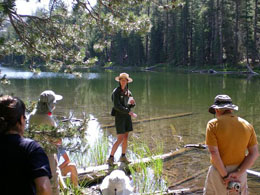
Adrianna tells us about life in the pond
|

Stream on the way to May Lake |
 Nancy
|
Adrianna talked a lot about “change” as a natural process of nature. She said that rivers and lakes change to meadows. Trees with roots in the soft mud that line the edge fall into the water, trapping sediments. Eventually the lake fills in and becomes a meadow. This is happening at Mirror Lake. Left on its own, Mirror Lake would become a meadow. The dilemma -- intervene and clear out the trees and sediment to preserve this famous lake or let nature have its way and turn Mirror Lake into a meadow. It appears that the “natural process” advocates are winning – and that sounds like a good approach.
Adrianna showed us where a flood occurred in January of 1997. Water and gravity are powerful forces that continue to shape the landscape.
1997 Flood
Once tall trees lined the river
Fallen dead soldiers
We stopped by an outcropping of rocks for an excellent photo op.

Bill and Nancy on the rocks |

Fred meditating |
The flowers were endless:
- Coneflowers with the spiral three leaf arrangement
- Yarrow - wide cluster of tall white flowers with a pungent aroma, used by Native Americans as a healing herb, and a drink to cure indigestion and fevers.
- Meadow goldenrod appears in late summer and fall and grows in long stalks and topped by a shock of yellow that resembles a feather, used by American Indians to cure all sorts of ailments.
- Members of the carrot family
- Wild chives – Adrianna picked a few everyday to add flavor to her sandwich.
- Sagebrush – Fred called it “cowboy’s bath”
- Lupine everywhere in all sizes and shapes – They’re like the lone wolf (Lupus) who grow alone . . . but come to find out, they grow where other’s can’t grow and replenish the soil by adding nitrogen back into the depleted dirt
- Mariposa lily – blooms beneath pines in Yosemite and is named for the Spanish word for butterfly
- Other assorted members of the Astor family – wild daisies

Lupine along the trail |
Three wild daisies
Gossiping as we go by
Giddy with laughter
A sea of sagebrush
Cowboy’s Saturday night bath
Ladies are waiting
The meadow’s chorus
Wild daises, the soprano
Coneflowers, the bass
Solid wall of rock
Tiny mariposa lily
Finds a place to grow
Purple hats, green skirts
Lupine Whirling Dervishes
Dancing in the breeze
We stopped to check out a burning tree struck by a lightning bolt about a week ago. In my ignorance, I asked if we should put out the fire. Adrianna replied, “No.” The park policy is to let it burn as part of nature’s process.
- A little fire here and there clears out the underbrush before it builds making a huge kindling for a full-on forest fire.
- The fire replenishes the soil.
- Some seeds don’t do their job unless they’re in a fire. For example, the Giant Sequoias are a fire-adapted species. Their bark is fire resistant and fire helps open the Sequoia's cone and scatter the tiny seeds.
- The remains of a dead tree here and there aren’t so bad because it supports an amazing amount of life.
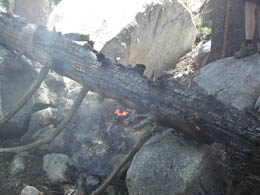
Lightning-caused fire
|
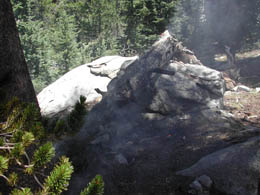
Where there's smoke there's fire
|
Hot smoldering ground
Singed by God’s sharp lightning bolt
Regenerating
Insects and fungi
A dead tree supports more life
Than a living one
We ate lunch with a panoramic view of Mt. Conness and Tenaya Peak. It can’t get any better than this!
After lunch we passed by Raisin Lake, a good swimming hole. Some of our group stopped for a dip, but Bill, Steve and I continued on. We knew we faced some fairly steep stretches about a mile from our destination, May Lake camp.
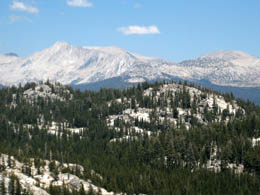
Lunch with a view of Mt. Conness |

Raisin Lake |
Long day of hiking
One brutal switchback to camp
God’s in the shower
We checked in with the usual welcoming lemonade. We have six assigned to our tent.
The May Lake camp is in a very pleasant setting. The tent cabins are nestled in the woods and the dining hall is near a beautiful lake under the shadow of Mt. Hoffmann. (May Lake is named after May, the wife of Senator Conness.)
We went to our tent to unpack and sort things out – bear box items, toiletries, dirty clothes, etc. We took a shower and washed our clothes. The sunlight quickly faded by our tent cabin so I moved our wet laundry down by May Lake on a rock to dry.
A group of about ten hikers from Massachusetts are on our same itinerary so we’ve gotten to know them. Pete has several bets going with them about who will win the World Series -- Padres or Red Socks. I stopped to do a little stretching and yoga with a new friend from Massachusetts before dinner. The downward dog felt great to us yoga practitioners. The call for dinner at May Lake blasted from a large conch, not the normal ringing of the “triangle” used in the other camps.

May Lake High Sierra Camp |

May Lake HSC Dining Hall |

May Lake |

Mt. Hoffman early in the morning |
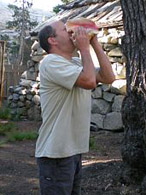
Blow your heart out
|
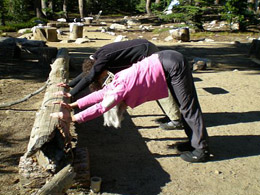
Nancy and Yoga Buddy do the downward dog
|
We are now experienced High Sierra hikers and know what to expect. Call for hot drinks at 6 and dinner at 6:30. We grabbed a table with Steve, Walter, Ron, Norma and Pete and consumed another delicious dinner – ravioli with meat or portabella mushrooms with tomato or pesto sauce with a quadruple chocolate cake (chocolate cake with chocolate chips, chocolate icing, and cocoa powder on top). They must have contests to see how much chocolate they can pack into a single dessert.
After dinner the May Lake staff introduced themselves. Jeff ran the place and his cousin is the cook. Cute guys with lots of personality.
Sad news for our group – Anne caught a bug and doesn’t know if she can continue the hike. She looks pretty bad.
A family from Bulgaria is visiting Yosemite. They have 3 sweet kids ages 7 – 10 who speak better English than any American children I know!
I was fooling around folding clothes and missed the first part of the Sunset talk. Pete, Norma and I couldn’t find the group – but finally we climbed up on a rock and there they were with a view of surrounding mountains overlooking Tenaya Lake. Adrianna gave her talk about some of the early settlers -- a couple of them had mountains named for them.
Adrianna pointed out Mt. Clark (11,000 feet) and told us the story about Grayson (Galen) Clark.
Grayson (Galen) Clark 1814-1910
Grayson Clark was a failure at business on the east coast. In the summer of 1854, when he was about 40, he came to Mariposa County. In the spring of 1856 his lungs hemorrhaged. The doctor diagnosed his illness as consumption and did not give Clark long to live. In spite of this, the next year, Clark (being an outstanding mountaineer) explored the Mariposa Grove of Giant Sequoias. He wanted to live out the rest of his life among the Sequoias so he moved up to the mountains and settled at what is now Wawona.
His ranch, known as Clark’s Station, became a way station for travelers coming into the valley. Clark for a time drove the first wheeled vehicle in Yosemite Valley, a wagon that was taken apart into mule loads, and then reassembled in the valley.
To prepare for his death, he made himself a coffin, carved his head stone, dug himself a grave and planted six Sequoias near the grave in Pioneer
Cemetery
in Yosemite Valley. Five of the Giant Sequois are still standing. He didn’t die until some 50
years later
at age 96. (His two nephews carved the final date of death into his head stone.)
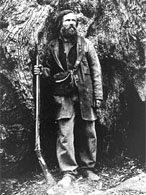
Galen Clark |
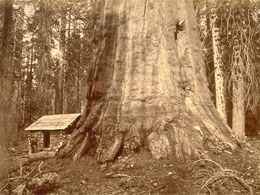
Galen Clark's Cabin |
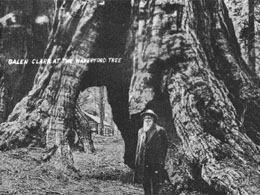
View of Galen Clark's cabin by the 85 Feet in Circumference Sequoia in Mariposa Grove
By Wm. H. Seward The Bancroft Library |
|
Then Adrianna shifted our focus to a taller mountain, Mt. Florence (12,000 feet) and told us the story of the wild, obscene teenager, Florence.
Florence Hutchings (1864 – 1881)
Florence Hutchings was popular and vivacious. She rode her horse astride at full speed – very unlady-like. Dressed like a boy, she would ride out to greet new visitors and then shock them when she removed her hat and revealed her long hair. The visitors, trying to teach her a lesson, would jump on their horses and chase her. She cleverly led them to her father’s hotel where they would check in for the night. She died at 17 climbing rocks in the area. Her funeral was held in the Big Tree Room of “The Hutchings House” (later called the Barnard Hotel).
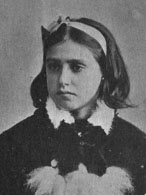
Florence Hutchings |
|
Each day Adrianna told us more and more about the real hero of this place, John Muir. She also read passages from his journal of the first summer he spent in Yosemite. Tonight her passage talked about how everything in nature is connected and “how we’re all hitched together.”
John Muir (1838 – 1914)
John Muir was an inventor, naturalist, and conservationist. . He migrated with his family from Scotland to the U.S. The family bought a farm in Wisconsin in 1849 at Fountain Lake, near Montello.
Muir worked on the family farm and found he had a talent for inventing things. He thought about a career in mechanical arts, but studied botany and geology on and off at the Univ. of Wisconsin from 1860 to 1863. To supplement his income he taught science in the local schools, but his real passion was to be alone with nature. He took extensive trips through the wilderness areas of the state.
In 1863 he left Wisconsin permanently, hiking through the surrounding states and Canada. In 1867 he moved to Indianapolis, Indiana, and found a job in a carriage-wheel factory, but that career ended when he injured his eye.
In 1867 he set out on a walking trek through the southern states and kept a journal (later published posthumously as A Thousand Mile Walk to the Gulf –1916. He walked to the Gulf of Mexico, but became sick and ended up in San Francisco in 1868. It is said that when he arrived in San Francisco, he asked for directions to "anywhere that's wild." Somebody pointed him toward the Sierra Nevada.
Legend has it that he shouted with joy when he first saw Yosemite. Over the next few years he found odd jobs in order to live in the valley. He was a mill worker, a shepherd and a hotel clerk. In his journals, he wrote, "As long as I live, I will ever after hear waterfalls and birds and winds sing. I'll acquaint myself with the glaciers and wild gardens, and get as near to the heart of the world as I can."
He really got to know Yosemite Valley when he was a sheepherder. Actually his job was to watch Billy Bob, the head sheepherder, making sure Billy didn’t steal any of the sheep. Muir observed and learned everything he could in the valley and was the first to explain the glacial origin of the valley at Yosemite.
Muir was also a guide and devoted many years of studying and exploring this area. He loved to risk life and limb in the wilderness in order to feel the force of nature. He climbed
dangerously
high over Yosemite Falls “giddy” with excitement. He strapped himself to a tree during a fierce lighting storm. Some people thought he was a nut, but he proved them wrong and was eventually recognized as one of the leading naturalists in the nation.
One summer, with his trusty mule Brownie, he traveled extensively in the Sierra Nevada to study the threatened territory. He was sad to see Yosemite invaded by cattlemen, shepherds and land speculators and concerned that the area would not survive into the 20th century. One argument for preserving the area was its value as a watershed for the water-dependent San Joaquin Valley agricultural industry. Muir worked to keep Yosemite intact and in its original state. Much of the credit for the establishment of Yosemite National Park and Sequoia National Park is given to Muir,
In 1889, John Muir and Robert Underwood Johnson, the influential editor of Century magazine, found the high country overrun with flocks of domestic sheep. Muir wrote of the devastation that these “hoofed locusts” brought upon the land. “They not only voraciously consumed meadows and wildflowers but also destroyed the soul of the land.”
John Muir and Robert Underwood camped together in Tuolumne Meadows – not far from Soda Springs, the place where we hiked during our first morning. On that fateful campout, Muir urged Johnson to do something about preserving this place. And Johnson did. He used his influence on key citizens and politicians back East to help preserve the region. Together Johnson and Muir planned a campaign to make the high country surrounding Yosemite Valley into a national park.
While Johnson lobbied for the park, Muir spoke and wrote of the need for legislation to designate the land as a national park, as was done when Yellowstone National Park was established in 1872. In just one year, Muir and Johnson were successful and on October 1, 1890, the U.S. Congress set aside more than 1,500 square miles of “reserved forest lands” soon to be known as Yosemite National Park. It included the area surrounding Yosemite Valley and the Mariposa Grove of Giant Sequoias. However, it took a meeting between President Theodore Roosevelt and John Muir in 1903, and the effective lobbying of railroad magnate Edward H. Harriman, to have Yosemite Valley and the Mariposa Grove ceded from the state of California's control and included with Yosemite National Park in 1906.
NOTE: The first Yosemite Rangers were the Calvary and their primary job was to control the sheep and cattle population in the valley.
As a conservationist and leader in the forest preserve movement, John Muir advocated preserving the wilderness in its natural state. He later traveled in South America, Africa, and in Alaska, where Muir Glacier is named in his honor.
One of the leading conservationists in the U.S., Muir, as much as any man in his day, showed the need for preserving our country's natural resources. Muir was a charter member and the first president of the Sierra Club, formed in 1892 to secure federal protection for the Yosemite region. He died in California on December 24, 1914, at the age of 76.
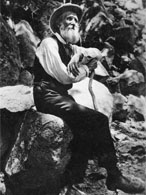
John Muir, 1907
Fultz, Francis M. , San Joaquin Valley Library System |
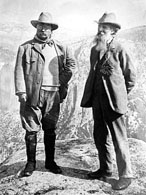
Roosevelt and Muir at Glacier Point May 1903
San Joaquin Valley Library System |
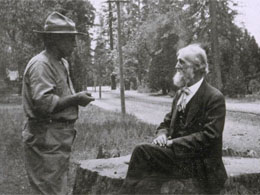
John Muir and friend in Yosemite, his last trip, 1912
Pictures by Mr. L. P. Bagnand, friend of John Muir, Pasadena, California The Bancroft Library. University of California, Berkeley. |
|
John Muir, Sheepherder
Visionary, Scientist
Where is he today?
After the sunset talk, Adrianna dashed down to the fire ring to start the evening camp fire. After she got the blaze going, she conducted a campfire talk on geology.
She started by asking the Bulgarian children to help her demonstrate the age of the earth. They held a four foot long string representing the earth’s timeline. About a foot in from Year 0 (the beginning of the string) was when the first single cell creatures came about and about two feet in (from year 0) was when dinosaurs came to be. Adrianna pretended to shave a little bit off at the end of the string to show when man first showed up.
Having established how much time the world has had to develop and change (before man even showed up), she was better able to relate the time it took for some basic geological concepts.
Using a couple of paper plates, she showed how the earth’s plates (slab or earth’s crust) move up and under or against each other causing different formations. She told us how this area was formed.
- 500-200 million years ago – The Yosemite was beneath a sea. Sediments accumulated on the ocean floor and grew to thousands of feet thick, compressing the layers into sedimentary rock
- 200-80 million years ago – Slab or earth’s crust (called a plate) slid under the North American continent causing tremendous heat and pressure. The down going plate melted into magma. The magma rose toward the surface and erupted to form a mountain chain of volcanoes. Much of the magma cooled and became granite.
- 60-10 million years ago – The earth’s plate movement stopped, but the erosions stripped away the volcanic rocks exposing the granite. There were low mountains with shallow river-cut canyons and lots of hardwood forests.
- 10 million years ago – Sierra Nevada’s “backbone” rose. The Sierra block uplifted and titled westward. The Merced River began to carve a narrow canyon and lots of Redwood forests.
- 3 million years ago – The Merced River carved the canyon deeper while its tributaries cut the land more slowly. Forests thinned as the Ice Age approached.
- 1-2 million years ago – Glaciers flowed from the crest of the mountain range into the river canyons. They filled the “V” shaped Yosemite Valley and then carved it into a “U” shape, forming hanging valleys with cascading waterfalls.
- 15,000 years ago – Ice age over as temperatures warmed and the laciers retreated from the valley. The rock debris dammed Yosemite Valley, creating a shallow lake. Sediment filled the lake flattening the floor of the valley as we see today.
The same process of sedimentation continues at Mirror Lake (and other lakes) as sediment fills in and they become meadows. Water and gravity shape the landscape like the Middle Brother rock fall of 1987 and the flood of January 1997.
After the campfire talk, I notice the new moon shining brightly over Mt. Hoffmann and reflecting in May Lake. I thought of my very good friend, Arlene, who died a few years ago. She loved the tiny sliver of a new moon and I loved her, so I went to my tent and composed another haiku to honor my wonderful friend.
New moon on May lake
On earth, she loved the new moon
Arlene is with me
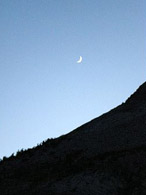
Arlene’s Moon |
My five other bunkmates were tucked into their beds, (some were gently snoring) when I turned off my headlight.
Six beds in a tent
Filled with six snoozing hikers
Rejuvenating
Day 3
Wednesday, July 18, 2007
May Lake to Sunrise
8.4 miles / 130 feet elevation gain
We woke up and went into our regular routine – retrieving items from the bear box, organizing our backpacks, coffee and tea at 7 followed by another massive breakfast at 7:30. After breakfast, we were ready to go. Our last act before hitting the trail was singing Walt’s farewell song to the staff at May Lake.
May Lake Farewell Song -- by Walt Davie
We loved all the time that we had at May Lake
But now comes the time our departure to take
Farewell and adieu, we're away from your shore
Bound for High Country and ready for more
|
We started with a thousand-foot descent (about 2 miles) to Tioga Road. As we got closer to the road, we heard the annoying sound of traffic on the road. I didn’t like being around cars and parking lots again. It just didn’t seem right.
The bug got Anne big time leaving her with chills and a fever. She needed to rest and recover. She bravely gutted out the hike for a couple of miles down to Tioga Road where she (and her friend Grace) caught the shuttle back to Tuolumne Meadows Lodge. We said our good-byes to the girls and wished them well. We were sad to see them go.
We started our ascent to Sunrise Lakes on some serious switchbacks with a lot of rock stairs. In spite of the tough hike, we stopped and waited for the others at trail junctions and other points along the way. Adrianna always had fascinating facts for us. She also quizzed us to see if we were paying attention.

Rock stairs switchbacks to Sunrise Lakes |
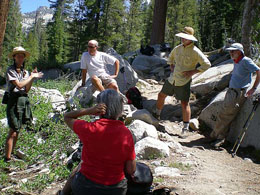
Trail to Sunrise |
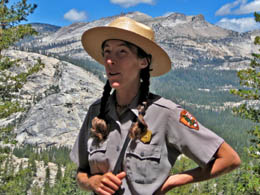
Adrianna sharing her world |

Packs off, resting in the shade |
Backpack slows me down
Twenty pounds of stuff strapped on
Weight lifted, spirit soars
Today we stopped for lunch near the Clouds Rest trail junction, a most magnificent spot with a clear view of Half Dome and Yosemite Valley. We sat quietly on some boulders munching on our huge lunch, not believing the place was real. Later, the Massachusetts gang caught up with us and joined us with their lunches. One Massachusetts woman irritated me. While I was trying “to be in the moment” with all this beauty, she grabbed a cell phone to call her office back East. It was obvious she wanted to impress her colleges back home, locked in their cubicles. Looking for a crisis she said, “Is there anything I need to know about?” I was glad when she settled on a rock out of my view.
Lunch on a high cliff
View of Cloud’s Rest and Half Dome
Image in my brain
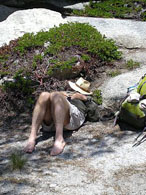
Siesta Time |
We stopped for a while to enjoy Sunrise Lake and then continued up the steep switchbacks.

Lower Sunrise Lake |

Lower Sunrise Lake
|

Lower Sunrise Lake |
My hiking poles helped me up the switchbacks and the music in my ears pumped up my spirit for those mighty big hills.
Ipod in my ears
Beats of African music
Sets my joyful pace
I have four legs
Two poles to tap out rhythm
Keeping feet on track
Once we passed the last Sunrise Lake, we climbed a little more until we reached the pass. From there it was about a one-mile descent to the Sunrise Meadow High Sierra Camp.
Bill and I were the first to check in – we were assigned to cabin #3 with Pete and Norma. I took off to the showers. The hot, steamy shower room was the promise of a luxury to come. However, the hot water was gone and I had to settle for a cold shower . . . and the toilets were the smelliest in the valley (the fan is broken). Oh well.

Our tent at Sunrise Camp |

Nancy and Norma |

Our tent nestled by a big rock in the woods |

Sunrise showers and smelly bathrooms |
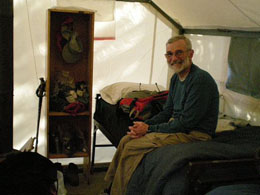
Bill on his bed |
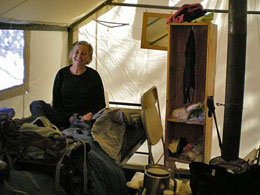
Nancy in her bed |

Dining Tent at Sunrise HSC |
Over the rocks and directly behind our tent cabin was a view of Long Meadow. It was gorgeous, but storm clouds were gathering and we all expected rain throughout the day.

Long Meadow behind our tent cabin |

Adrianna studying her notes on the rocks overlooking the meadow
|
The “Weiner father and daughter team”, Mike and Karin, invited our group to a cocktail party featuring vodka and lemonade “on the rocks” overlooking the meadow. (Earlier in the day, Karin passed out official funky little invitations to make the party even more special.)
At 5:30, “the party on the rocks” was glorious and gave us a chance to really bond. We especially adored Walt and his wonderfully strange songs and comments. These parties became a regular part of our day. Bless those guys who lugged those “spirits” all over the mountain – The vodka and lemonade were a real hit. Right after our party, the looming clouds blew away, never to return for the rest of our trip. Now that’s magic.

Cocktail hour on the rocks |
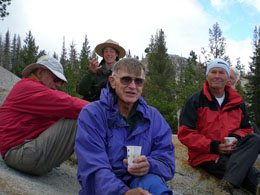
Cheers!
|
Our group became one
Helped along by friendship juice
Vodka makes us laugh
Our dinner that night was very special – curried halibut with veggies cooked in rice paper – plus the usual dinner rolls, salad, soup and dessert. Love eating like a pig and not gaining any weight. We sat with Scott, Ron, Steve, and Karin – and got to know them even more.
Adrianna gave a sunset talk on the rocks overlooking the meadow and immediately after, we went to the fire ring where she lit the campfire and gave a campfire talk on animals. How does she do it?
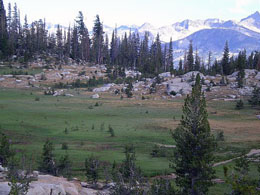
Long Meadow |
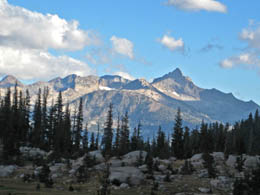
Right before sunset overlooking Long Meadow
|

Adrianna at the Campfire |
Loud, crackling embers
Ragged flames cut the night sky
Warm glows, choking smoke
The topic at campfire that night was bears. There are no grisly bears in California – They only exist on the Californian state flag. The last grisly bear was killed one year before the park opened. However, Yosemite is famous for its black bears, whose color actually varies from blond to cinnamon to brown to black. They got their name “black bear” from the species on the east coast.
About 300 to 500 American black bears live in Yosemite. At one time the rangers actually fed the bears to entertain visitors. That was a mistake because the bears formed bad habits and came to depend on human food and cause all kinds of trouble.
The babies are born weighing a whooping 8 ounces. The typical adult male weighs 300–350 pounds while the female weighs in at 200-250. In the 1970’s, a 600-pound black bear was spotted in the park. (And Wild and Crazy Ranger Dave claimed that 600-pounder was the very one who stalked him and his buddies on one fateful night – more on that tale later.)
Black bears have a powerful sense of smell, are very intelligent and are excellent learners. Bear boxes, normal equipment at the park, have squelched some of the bears' efforts at stealing food, but that doesn’t keep them from breaking and entering into other places, such as cars. One bear was named the “Camero Bear” because he only broke into Camero cars. Some bears have leaned to throw the bear barrels off high places to
break them
open.
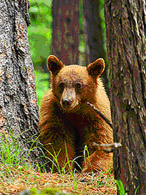
Black bear (“borrowed” from the Internet) |
Adrianna also told us about the squirrels at the park. She hopes they never get to be human size because they are very aggressive. She told us about the Belding ground squirrel which is like a prairie dog. They are matriarchal. The females live together in a tight communal group while the males hang out at the periphery. The males and females meet one day a year, (say from 10 to 3), for the sole purpose of mating. The whole area becomes a Belding squirrel orgy. One year, a ranger was walking his dog on mating day.
The dog disturbed the squirrels’ activity so that the next year, there was a big drop in the baby squirrel population.
The squirrels have a distinct warning signal. A lookout squirrel stands up and whistles one screech for predators spotted overheard and whistles three screeches for predators approaching on the ground. (Interesting enough, Steller's jays and other birds in the area are wise to these signals and will pass them along
to their feathered pals
in “bird language”.)
Tree squirrel’s warning
“Hikers on the trail,” he yells
Jay passes the word
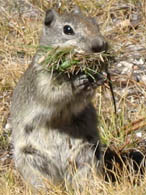
Belding Ground Squirrel |
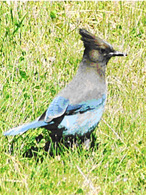
Steller's Jay
|
Adrianna could make the sound of the gray owl’s call. (One day on the trail, we heard the Olive sided flycatcher call in the trees above. She taught us the phrase – “Quick, 3 beers” to remember his call.
Listen to the birds
Fly catcher calls, “Quick, 3 beers”
I’ll pick up the tab
Finally, Adrianna told us about the little fur ball called a Pika.
The Pika is a small mammal related to rabbits and hares and is found in Sierra Nevada.
The little character is multiplying like crazy and migrating to higher elevations in Yosemite, possibly due to global warming. One study showed that today in Yosemite, there are more animals present (like the Pika), but less diversity of animals. Ravens are an example of birds who have come and multiplied and are nosing the others out.
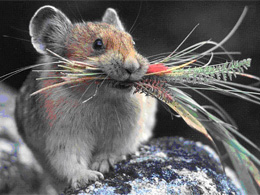
Pika (“borrowed” from the Internet) |
After the campfire program, we went to bed. Our cabins were cold with temperatures dipping down to 38 degrees. Most of us had trouble keeping warm that night.
Day 4
Thursday, July 19, 2007
Sunrise to Merced
10 miles / 2,250 feet elevation gain
We knew the routine well – breakfast at 7:30 . . . packing . . . farewell song to the Sunrise Camp staff . . . backpacks on and off we go.
Sunrise Camp Farewell Song -- by Walt Davie
Say farewell to Sunrise, it's the place of our repose
We loved everything about it but the blisters on our toes
And as we travel onward along the dusty trail
We will say goodbye to Sunrise and to their staff All Hail!
|
Filtered morning light
Good rest, full tummy, strong legs
Day full of promise
In our 4th day of hiking, we descended over 2000 feet in 10 miles on our way to Merced Lake. The trail was generally southward with some steep parts along the way.

Trail to Merced Lake |

Along the Trail
|
Pine smell in my nose
Warm sun on my head and chest
Dust clouds on my boots
I think it was today that Adrianna introduced us to the private world of fungus.
| Adrianna's Lesson on Fungus
Fungus is our friend, yet we think of it as only an annoyance (like in athlete’s foot). However, without fungus, there’d be no trees or plants. Land plants and fungus evolved together and both are dependent on each other.
Mycorrhizal is the big daddy of all fungi. It’s found on the roots of most plants in their natural habitats. When we see a big tree, we think of the tree's strength and independence. However, the roots of that tree cannot exist without life-giving fungus. (That goes for all the flora we see in nature. Cultivated plants have a different root system.) Fungus is everywhere, tucked underground with its string-like connections. It is truly a “world-wide web.” (The mushroom is the flower of a fungus.)
A few years ago, Adrianna was working in Oregon with the task of bringing a forest that had been dead for over five years back to life. No matter how much clearing and cultivating she and her team did, it really didn’t matter because the fungus, the life-giver of all, was dead. We spoke in reverence toward Mycorrhizal after that story.
Sometimes fungi make plants do some strange things. Andrianna pointed out a “witches broom” – a branch growing out of the side of a pine tree and down towards the ground. A particular fungus can cause a weird aberration to the plant, but according to Adrianna, most are not harmful.
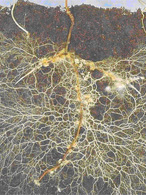
Mycorrhizal Fungus |
|
Fungus is my friend
Small, powerful, life giving
Not an annoyance
Supplies life to all
Great Mycorrhizal fungus
God’s beneath the soil
Adrianna told Bill, Steve, Fred and I that we could go ahead of the group and then stop at the second bridge for lunch. It was another beautiful lunch spot. We crawled down to the edge of the stream and dangled our feet in the cold water. We watched a couple of trout and just relaxed.
The rest of the gang came along later and we enjoyed our wonderful lunches together. The troops were all happy in spite of some ailments. Norma and Karin were nursing their collar bone wounds caused by their backpacks. Scott was treating his open abdomen wound from his bike accident. A lot of the gang was suffering from blisters. Adrianna performed surgery on Norma’s big toe. I was glad I didn’t have any wounds to lick and quietly thanked my trusty hiking boots. However, I noticed the soles are wearing thin and some of the stitching is coming a part. Sad to say this could be our last trip together.
Love my hiking boots
Carried me around the world
Time to say “Goodbye”

Bridge over troubled water – Wound licking time |

Lunch stop |

Ron’s blishers |
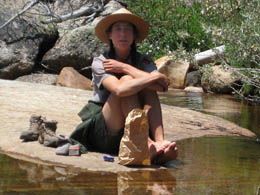
Adrianna, our fearless leader |

Scott enjoying the cool water |
After lunch, we packed up, squeezed our rested feet back into our boots and headed down the trail. Somewhere along the way Karin spotted a bear in the meadow. I was hiking with Pete when he said, “bear to the left.” I interpreted that to mean: “Go to the left.” While trying to figure out what to do, I missed a very close up and personal view of the bear. The bear ambled off into the meadow occasionally turning his head to peer over the tall grass to check on us. His fur looked like honey in the bright afternoon sun and his pointy ears swiveled around trying to pick up our sounds. After a few minutes, he nonchalantly just walked away.
Bear in the meadow
Five intruders stop to stare
The bear could care less
Next, Ardianna took us off trail to a flat granite area rich in archeology. She asked us to look for something interesting. “Eagle eyed” Fred finally spotted about five or six Indian grinding (or rather, pounding) holes and a few pieces of obsidian scattered by a nearby rock. We imagined a Native American sitting on the rock chipping away at the obsidian, making arrowheads, knives or other Indian things. The view was wonderful – probably a great place to meet with your tribe (and other tribes), gossip a while, pound acorns and do whatever else Native Americans did years ago in their magnificent homeland.

View from the Archeology Site |
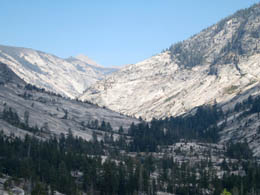
View from the Archeology Site
|
Scott picked up three pinecones and went into a juggling act. He’s a multi-talented guy. Smart, too, so I’m sure he was using pinecones from the Jeffrey Pine tree.
NOTE: Two common pines at the lower elevations are the Ponderosa pine and Jeffrey pine (both known as "yellow pines"). Ponderosa pines have yellow-orange bark scales that fit together like a jigsaw puzzle and needles grouped in threes. The Jeffrey pine is similar to the ponderosa but tends to live at higher elevations. Jeffrey pines smell like butterscotch and their pinecones, unlike the Ponderosa, have no prickly edges. As Adrianna said, "gentle Jeffrey, prickly Ponderosa."

Scott juggling three pinecones |
Gentle Jeffrey Pine
Pinecones easy to caress
Smells of butterscotch
Gentle Jeffrey Pine
Ouch, Prickly Ponderosa
Careful what you touch
Our next stop was at Fern Grotto, a peaceful little swimming hole surrounded on one side by cascading falls. I laid on a rock and dangled my feet in the water. Mike and Walt went in for a swim.
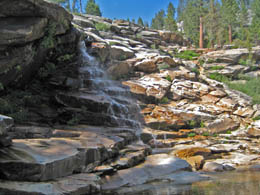
Fern Grotto |

Fern Grotto |
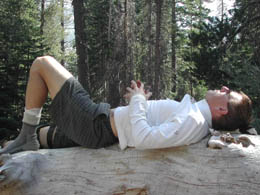
Scott sawing logs
|

Nancy sawing logs |

Cascading Falls
|

Karin by the waterfall |
The day was wearing on. We had lots of stop and go. Bill, Fred, Steve and I wanted to forge ahead. Adrianna released us to go on to Merced Camp and we took off with new energy. Some of the trail was over large flat boulders, but was fairly well marked, so we didn’t have any trouble navigating.
We came to an open meadow thick with Lupine and mountain ranges as the backdrop. I couldn’t believe my eyes. Fred was blown away too. I found him kneeing in beds of Lupine trying to capture the perfect picture. It was glorious. (Later, Adrianna said she had never seen so many flowers in that place before.)

Trail of Lupine |

Meadow of Lupine |
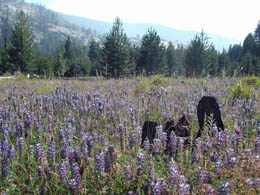
Fred’s Field of Lupine |
We eased on down the trail through some switchbacks to Echo Valley. When we reached the junction, there it was, the mighty rushing Merced River. We were all overwhelmed by the sight and sound so we stopped for several photo ops.

Merced River |
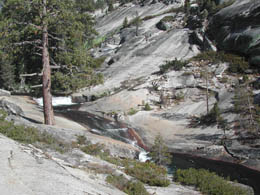
Merced River |
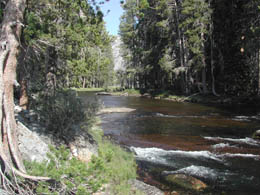
Merced River |
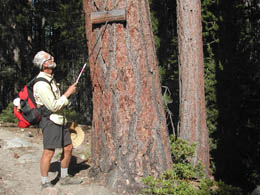
Fred checking out the sign |

Bill and Nancy Next to the Merced River |

Bill and Nancy |
We put our cameras away and continued on. The trail hugs the river on the right then flattens again as it arrives at Merced Lake—another amazing sight!

View of river from the trail |

Merced River |

Merced Lake |
We continued along a fairly narrow area between the mountain and the lake. This trail is full of Aspen and the world's largest Sugar Pine (although I was so anxious to get to camp that I missed the giant pine). Merced Lake High Sierra Camp was at the far side of the lake.
The camp at Merced Lake is the oldest of the High Sierra Camps, established in 1916. The tent cabins were arranged in military barracks fashion – 3 straight rows of eight tents all facing inward toward the fire ring.

Merced Lake the High Sierra Camp |

Army barracks – tents all lined up |

Home Sweet Home - Tent #8 |
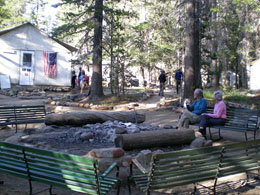
Merced Lake Campfire Ring |
Bill and I were assigned to Cabin #6 with Pete and Norma. Luckily, there were extra tent cabins so Bill and I were able to switch to Cabin #8 and have our own private place. I know Pete and Norma liked their private tent as well.
We organized our stuff, took a wonderful shower and then joined the rest of our group for “cocktail” hour. Several of the Massachusetts gang was hanging outside their tents nursing some pretty brutal-looking blisters. Wonder what the pioneers did without the latest in boot wear?
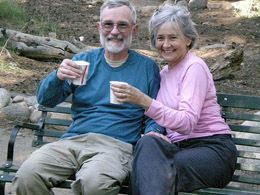
Cocktail Time! |
We heard the dinner triangle's loud clanks calling us for hot drinks and then for dinner at 6:30. Dinner that night was a pork roast and, of course, some killer chocolate concoction. Really loving this life style. As usual we met the staff after dinner. The cook was from Alabama and set a land speed record to from Alabama to Oakland. He said he just couldn’t wait to get out of Alabama and into California. There was a darling brother and sister team on the staff. The sister was very friendly and “out-there.” During off-season she’s a fire thrower. Her quiet brother is a musician. I admired their affection for each other – wish I could be like that with my brothers! Another member of the staff was from Nashville. They all seemed to have such fun together.

Merced Lake Mess Hall |

Dinner Triangle |

Homely little camp |
After dinner we had a campfire talk. Adrianna did an interesting thing. She took a seed (the size of an oatmeal flake) out of her little black pouch and asked us to be very careful not to loose it as we passed it around the circle. With such tender lovingness, the tiny seed completed the circle of 25 people and made it safely back to Adrianna’s little black pouch. Then Adrianna announced that the tiny seed was the seed for a giant Sequoia. All the information for building that gigantic tree was contained in the tiniest of packages.
One Sequoia seed
The size of an oatmeal flake
Makes the largest tree
NOTE: I was amazed at the treasures Adrianna stored in her little black pouch – notes for her campfire talks, photocopies of John Muir’s journal, seeds, carcasses of fallen larva, miniature copies of artists’ work (Ansel Adams, Chiura Obata), samples of leaves and on and on. The black pouch was like her briefcase of visual aids for her office in the mountains– only the items contained within were small, precious and carefully selected. During her talks, she was a magician pulling out of her black bag some magic to share with all of us.
After the campfire, Norma hatched a trick. Because the “couples” tents surrounded the guys’ tent -- Bill and I on one side; Norman and Pete on the other -- Norma wanted to stage a “love-in” for the single guys’ entertainment. At the precise same moment, she and Pete and Bill and I were to scream in ecstasy – like we were teens again. Bill thought it was rather strange, but I went along, jumping on the squeaky bed and making throaty noises followed by giggles. Norma and Peter in their tent did likewise – but our giggles drowned out any authenticity of the dramatization.
We finally settled down and went to sleep. I woke up in the middle of the night with a very full bladder. I didn’t want to put on my layers to brave the outside, so I just found a few extra Dixie cups – hope this isn’t too much information!
Got to pee so bad
Warm and cozy in my bed
Struggle, then relief
Day 5
Friday, July 20, 2007
Merced (free day – Washburn Lake
6 miles round trip
Day 5 was a free, layover day at Merced Lake. After breakfast, Bill washed the clothes. (He does a much better job than I!)
For our free day, Bill and I decided to hike to Washburn Lake (a roundtrip distance of about 6 miles) with Adrianna and Fred. Stevie and Norma stayed back at camp to read and relax. Mike, Karin and Pete went fishing at the far end of Lake Washburn. Scott and Walt did a killer off trail hike and some heavy father-son bonding because of the several near death experiences they shared.

Steve reading at Merced Camp |
Adrianna, Fred, Bill and I started out at 10 o’clock on the trail at the back of the Merced Lake Camp.

Merced River (beyond the camp) |

Rapids - Merced River |
The trail was easy (and flat for the first few miles). It was especially easy without our heavy backpacks. When we reached the junction to Vogelsang we continued straight towards the Ranger Station rather than turning up towards Vogelsang. After about a mile we were alongside the Merced River. Once at the river, we began to climb slightly, eventually getting a bit steeper, but at a fairly slight incline.

Ranger Station |

Nancy, Fred and Adrianna |

Bill and Nancy |

Washburn Lake |
I was happy Adrianna was along because I learned even more about the flora in these parts.
| Conifer’s Old, Inefficient Way of Reproducing
Adrianna said that pine trees use an old, inefficient way of reproducing. The later, more evolved and modern method is the flower system of pollination. Flower pollination / reproduction is a snap. Flowers just put their reproductive organs out there for all the world to see and then kick back and let the birds and the bees and the butterflies and the wind do the work. Not so for the old pine tree. It takes 2-3 years for the pinecones to release seeds.
I needed serious pinecone education and Adrianna was just the person to do it. Sorry to show my ignorance but I didn’t even know that “conifer tree” referred to cone (as in pinecone tree). The trees native to Yosemite are mostly conifers and broadleaf trees. Conifers have needles and cones, and do not shed in the winter like the Broadleaf trees.
I also didn’t realize that there are two types of pinecones on a tree -- male and female. The male cones (the little ones with pollen) are small and short-lived. In my pre-high sierra trek days, I only saw the female pinecone on pine trees – the ones we see on Christmas wreaths.
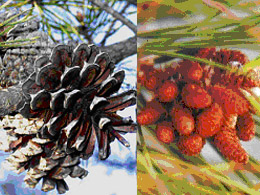
Female pinecone / Male pinecone |
Conifer tree reproduction management is time consuming and requires a lot of things to happen right on queue.
Female cones produce sticky resin and at the base of each spirally-scale is an ovule containing an egg that will, or rather, has the potential of, developing into a seed. In the spring, the male cones produce large amounts of pollen that is scattered by the wind to the female cones. The male cones grow on the upper branches so that they can scatter the pollen more easily fertilizing other conifer trees (and not their own) in the area (better for a diverse gene pool).
Resin on the female cone traps the pollen so pollination can occur. A tube from the pollen grain takes a year to grow to the ovule so a sperm can fertilize the egg and form seeds. A couple of years after pollination, the job is still not done. The seeds then have to develop on the upper surface of the large woody scales of the cone and take “wing” as they fall and scatter to the ground. Now that is one hell of a process just to get some seeds released to the ground and hope that some of them will take root.
|
All sizes and shapes
Pinecones litter hiking trail
Seeds for the future
Flora and fauna
Life, death, the resurrection
The cycle goes on
We saw a lot of ferns and delicate flowers on the trail that grow in wet, moist areas like meadows and springs from rocky crevices . The flowers were gorgeous -- mariposa lilies, coneflowers, eagles (or is it Shooting Stars?), monkey faces, elephant heads, tiger liles, and columbines to name a few. Hummingbirds love the columbine flower. I also noticed some unusual blue butterflies pollinating the flowers. Adrianna said they were called “blue butterflies” – imagine that!
NOTE: Another interesting fact from Adrianna - when we see a flower (for example, a daisy), we think of it as pedals around the pollen-producing center (stamen). Little did I know that each pedal and each stamen is actually an individual flowers grouped together to form a flower as we know it. “He loves me, he loves me not” is ripping away individual flowers, one at a time.

Columbine |

Tiger lily |
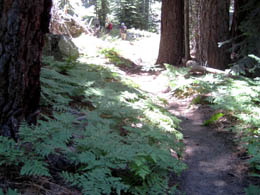
Trail through Forest and Ferns |

Trail by the Merced River |

Wild Daisies find a place to grow |
When we neared the lake, we passed just above the river along granite slabs. Washburn Lake was a great spot for lunch. We ate our lunch
sitting on boulders
overlooking the lake. Adrianna brewed some tea with some pine needles she collected along the way. I thought the tea tasted “too earthly” so I said, “Thanks, but it’s not my cup of tea” – which brought some laughter from the group.

Washburn Lake |

Bill by Washburn Lake |

Fred, boots off, lunch by the Lake |

Adrianna having her tea by Washburn Lake |
The lake was named for Henry Washburn (1836-1902). He operated the Yosemite Stage and Turnpike Company and developed the Wawona Hotel Company. His lovely wife, Jean Washburn (1838-1904), was listed as a “Poetess of Yosemite" – with a poetic soul she must have loved this place. (Thanks to the San Joaquin Valley Library System for these cool pictures.)
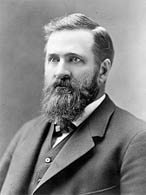
Albert Henry Washburn
(1836-1902) |
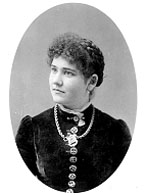
Jean Bruce Washburn (1838-1904) |
After lunch, Bill and I packed up and returned to camp. Fred and Adrianna went farther down the trail

On the return trail to camp |

River, rocks and flowers – beautiful day |
There was a lot of excitement when we returned to camp that afternoon. Ranger Dave brought Anne and Grace with his group to our camp. Anne recovered from her illness and rejoined our group, along with Grace. It was great having them back.
Conquered the mountains
Anne and Grace conquered illness
Broken leg got Dick
Mike caught a trout on his outing with Karin and Pete. I
tried a piece of
the trout at breakfast the next morning. It was mild and tasted like no other fish I’ve ever had.
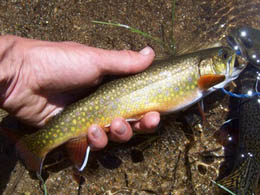
Mike’s fish |
Walt and Scott came dragging back to camp around cocktail time. They had horror stories of their day’s adventure. They were wedged between towering rocks, trapped in canyons, stuck in precarious spots. They seemed to have defied death at several turns on the trail. I knew it was scary because they have logical, engineering minds and discussed the dire situations in the most analytical ways. Their voices were void of emotions, but their eyes were big and expressive. Walt needed a cocktail right away. Then with his elfish chuckle, he told us other stories of his life as a wild and crazy guy. He recounted the riggers he put his girlfriend through as a test for “wife-hood” (she passed) and then how he rappeled down the Campanile (tower at UC Berkeley) in 1952.
Wall-Climbing? ‘I Can Do That’ - excerpts from Michael Kay’s article
The Daily Californian, May 21, 2007
The first unofficial ascension of the Campanile [at the University of California, Berkeley] tower was in 1952. Walt Davie, then a student and a resident of Bowles Hall, said he and fellow members of the now-defunct UC Hiking Club had been heading regularly to Yosemite to climb until they found “The Night Climbers of Cambridge,” a 1937 book chronicling climbing feats on the English university’s campus.
“We began to realize that we could do that and not have to make that long jaunt to Yosemite, which was sort of tedious at that time,” he said.
Members of the club had already climbed about 15 campus buildings, including Memorial Stadium and the Hearst Greek Theater, according to Davie, when they decided to sneak up the Campanile in the dead of night—using a key and the stairs—in order to rappel by rope down the 307-foot tower. Unlike many of those who came after them, they were caught, but the punishment was minor: a ban from extracurriculars, Davie said.

Walt – 75 and still one tough dude |
|
We could listen to Walt’s stories, accented with a delayed laugh, all night . . . but the dinner triangle clanked and we were off to the Mess Hall for massive quantities of pesto chicken and decadent chocolate wonders.
Ranger Dave gave our campfire talk
that night
on encounters with bears.
Ranger Dave is completely out of control. His wild, unruly hair shoots out from every angle that is not anchored down by a ranger hat (or unofficial baseball cap). His voice booms and his crazy eyes go in every direction. He is the center of a swirling vortex that must somehow be tranquilized. Being exposed to Ranger Dave was a shock to our systems after five days with soft, gentle, thoughtful, knowledgeable Ranger Adrianna – but what a show Ranger Dave put on for us.
He built the biggest campfire ever and told us that being a pyromaniac was part of his job requirement as a ranger. Then he told us the story of when he and his buddies went on a backpacking trip back in the '70’s. A huge bear (the legendary 600-pounder) was stalking nearby campers and then Dave and his buddies. With such drama, he told us how he heroically stood up to the big bear and how he and his pals marked their territory (peeing on the surrounding trees, of course). I never laughed so hard in my life – tears were streaming down my face. I wanted to produce a new movie “Jack Ass does Backpacking” with him as the star. I know it would be a hit. The evening ended when Ranger Dave (or Danger Rave, as he referred to himself) added a big waxy box carton to the dieing flames. The box ignited with such gusto that those of us on the front row had to run for cover. Now that’s entertainment!
After Ranger Dave’s highly charged campfire experience, I was ready for Adrianna’s night hike and a little sanity.
Adrianna opened our eyes to new wonders found in the dark. A group of us met outside the Dinning Hall and walked in the night air a little beyond the camp. The outlines of the tall pine trees pointed to the brilliant twinkling stars overhead.
A walk in the dark
Diamonds sparkling overhead
Trees point to heaven
At first Adrianna conducted some interesting experiments to demonstrate night vision and to show us how to rely on our senses other than sight to guide us in the dark. She passed out pairs of color swatches and we had to find the person who had a matching swatch. It wasn’t an easy task in the dark. Colors didn’t count as we could only see shades of gray. My color match partner was a gal from Massachusetts. We had to “partner-up” and stay together on the trail that night. The woman insisted on linking arms and clinging to me, which tended to pull me off balance – but I didn’t have the nerve to say, “Leave me alone!”
The next experiment was looking at a person standing about 8 feet away from you. I swear after a few minutes the head totally disappears. I saw only a coat and a hat. I thought I was nuts and the only one with such a phantom vision so I yelled, “My god, their head is missing.” The others had the same experience. Adrianna told us it was how the cones (of cones and rods) in the back of our eyeballs interprets gray – flesh tones are gray at night. (I know there’s more to it than that – maybe it’s the angle of the cones – If someone remembers, let me know.)
Adrianna passed out chocolate chips and instructed us to eat one while holding our nostrils closed and then try one with our nostrils open. Without the sense of smell to rely on, the flavor really disappears. Didn’t want to waste any more chocolate chips calories without my sense of smell.
The final experiment was when Adrianna invited us up to a Jeffrey Pine to smell the bark. You could detect the slight scent of butterscotch, but when she asked us to moisten the tips of our nose (lick our finger, dab it on our nose), the butterscotch smell was so powerful. That’s why most animals run around with moist noses, I suppose.
I loved our mini hike through the tall pines and over the granite by the river. The new moon wasn’t very big, but boy was it bright, making the granite slabs look like mounds of snow. The night was peaceful and quiet, although we heard an occasional bird (maybe an owl).
Moon light on granite
Lit like glowing drifts of snow
Magical evening
Because I have pretty bad night vision, I was afraid of missing a step and falling and twisting an ankle so I took it easy with my ever-linked partner. I stepped in some squishy stuff – knowing full well that it was fresh mule manure that littered the trail. During the day we avoided stepping in that crap, but at night it was interesting to press down into the dung and feel the bits of hay. It was a very magical night – something I would have never done without Adrianna as our guide – but now I’m ready to experience the night whenever I can.
Day 6
Saturday, July 21, 2007
Merced to Vogelsang
7.6 miles / 3,150 feet elevation gain
| Lake Merced Farewell Song -- by Walt Davie
Farewell and adieu to you, Lake of Merced
We now turn to face the long trail ahead
We loved the attention of wonderful staff
And the jolly campfire that gave us a laugh!
Too Ra Lie / Too Ra Lee
We have to see more of Yosemite!
|
We got our stuff packed and went for a HUGE breakfast. We’ve learned how to pace ourselves and eat everything in sight – oatmeal (with coconut), pancakes, bacon / sausage, fruit, and egg scramble.
This morning they were packing up the mules right behind the dinning hall. The High Sierra Camps need many beasts of burden to keep us happy and well fed.

Packing up the Mule |

Long Trail Ahead |
Today (the sixth day on the trail) was the killer day – 7.6 miles and an elevation gain of 3,000 feet. We would go from the lowest camp (Merced Lake) to the highest camp (Vogelsang), hiking northward along Fletcher Creek. There was a steep climb before leveling out and we all got a very good workout on an endless trail of "cobblestones."
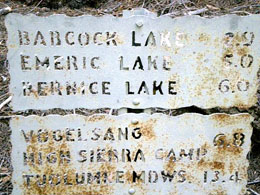
Trailhead to Vogelsang |

Nancy and Steve on the trail (9:30 am) |

Cobblestone trail |
With the cobblestones behind us, we got a little break and actually descended a little. Soon we crossed a footbridge and begin to climb again. There were some really good views here, but it was a hard walk up. Eventually we made it past the dome and into a meadow where the trail flatten out for a while.
Obstacles on trail
Roots, rocks, fallen trees and creeks
Fun, yet challenging

Scenes from the trail |

Scenes from the trail |

Scenes from the trail |

Scenes from the trail |
We stopped to rest (and to have lunch, if memory serves me) on a huge slab of granite. Around us were sad looking pine trees (mostly Lodgepole) infested with the pesky little needle miner moth (Coleotechnites milleri). These moths are endemic to the upper Tuolumne and Merced River watersheds of Yosemite. The larvae actually burrow into thin little Lodgepole pine needles and then live mostly within the needles for two years. Only in July of odd-numbered years do they emerge as a little gray moth for a few weeks. Coming of age in odd-numbered years is a clever way to keep predators guessing and not depending on the little gray moth for a food source. Fred brushed by a pine and several were released into the air like fairy dust. It is July and an odd-numbered year!
From her black pouch, Adrianna pulled out an open cotton ball to explain how mono-cultures (trees or flowers) are vulnerable to widespread infestation or disease. Farmers planted row after row of just cotton that depleted the soil and helped insects to spread through the plants in epidemic proportions. The same is true of forests. For example, when a forest has only Lodgepole pines, no other trees are there to block the spread of insects that just adore munching on Lodgepoles. For the most part, Yosemite’s wildflower population is diverse (multi-culture) keeping infestations at a minimum.

Our group takes a break |

Pete and Norma, Darling Couple |

Fred |
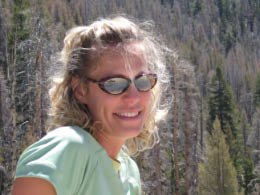
Karin |
At the back of the meadow was a small pool beneath a cascade and then the trail begin to climb again. At the top, the trail flattened out through a gorgeous meadow. We crossed the river a few times.
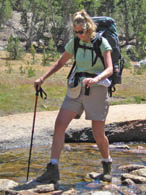
Karin crossing a stream |

Mike taking a rest |
Andrianna parked us on some rocks to let us rest a bit while she told us about artists who were “drawn” to Yosemite. Out of her little black pouch, she pulled some miniature copies of woodcarving prints of Yosemite done by Chiura Obata and passed them around.
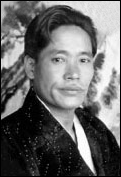
Chiura Obata (1885-1975)
|
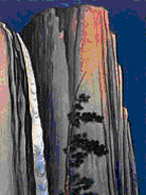
Evening Glow at Yosemite Falls1930
|
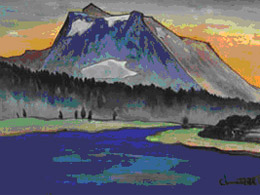
Sundown at Tioga |
| Chiura Obata-1885-1975
Chiura Obata, a well-known Japanese-American artist, was born in 1885 in Okayama prefecture. He was adopted by his uncle, an artist, and at age 14, he went to Tokyo to study ink painting.
In 1903 he moved to San Francisco. He worked as a commercial illustrator for different newspapers. During the 1906 San Francisco earthquake, he made on-site sketches of the destruction.
His favorite subjects were Californian mountain landscapes. In 1927 he visited Yosemite and the Sierra Nevada - painting and making sketches.
In 1928 Obata returned to Japan, following his father's death. While in Japan, he supervised the production of 35 colored woodblock prints of California landscapes for his World Landscape Series.
In 1932 Obata Chiura returned to the US and was hired as an art instructor at the University of California, Berkeley.
In 1942 Obata Chiura and his wife Haruko were among the more than 100,000 Japanese Americans who were moved from their homes on the West coast into ten relocation camps. Chiura made about hundred sketches and paintings during his internment in different camps. He organized an art school for the 8,000 Japanese Americans in Topaz (Utah). In spite of our country’s treatment toward Japanese, Chiura was still patriotic and loyal to America. Several other interned Japanese were out to cause him harm. For safety, he was released from Topaz in 1943 and moved with his family to St Louis. He got a job there with a commercial art company.
In 1945, when the military exclusion ban was lifted, Obata was reinstated as an instructor at U.C. Berkeley. He was promoted to Associate Professor of Art in 1948. After his retirement in 1954, he continued to paint, sketch and to travel through the American countryside. In 1965 he received an order from the Japanese Emperor for promoting cultural exchange between the United States and Japan. Chiura Obata died in 1975 at the age of 90.
|
After her discussion of Obata Chiura, she told us how Ansel Adams came to Yosemite and, like Chiura, was seduced by this amazing area. Both Obata Chiura and Ansel Adams were living (and doing the artist thing) in San Francisco before the earthquake of 1906. In fact, Ansel Adams even broke his nose during the earthquake. After his house was destroyed, Adams camped outside, photographing all the destruction. He found he liked camping. He eventually decided to go to Yosemite and photograph that landscape (rather than becoming an architect). Ansel Adams' photographs of Yosemite are world renown – In fact when we think of Ansel Adams, we think of Yosemite. He did much to show the world Yosemite’s beauty.
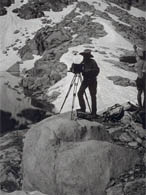
Ansel Adams working in the 1930s
The Bancroft Library. University of California, Berkeley |
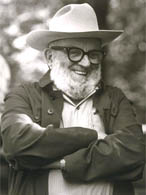
Ansel Adams at Landell-Hill Big Creek Reserve Dedication, 4/29/78. Photo by N.H. (Dan) Cheatham, 1978.. The Bancroft Library. University of California, Berkeley |
After Adrianna’s talk, we hit the steep trail again. By now we were all tired and anxious for the climb to end. Fred was ahead of me at the end of the long, grueling, relentless hike. I watched him always at a higher level wondering when would we finally crest. At last, the struggle was over as the trail leveled out. I felt like a stud. I puffed my chest out and could hear the melody from “Chariots of Fire" playing in my head. We had arrived!
Struggle up a hill
Have I enough to go on?
Triumph at the crest

Vogelsang Peak
|
This part of the trail is forested, but the trees become more sparse as you ascend closer to timberline. Finally we were at the Vogelsang High Sierra Camp, the jewel of the High Sierra Camp system.
We checked in with lemonade, always there to greet you. We were assigned to a cabin with Norma and Pete, our ole bunkmates. I was exhausted and just wanted to unpack, clean up and recover. I managed to freshen up (without showers) and then just laid on my bed. It was a hard hike and we all we tired and sad to have our last night together.

Vogelsang High Sierra Camp |

The tent we share with Pete and Norma |

The familiar bear box |

Nancy headed to the bathroom |
Meanwhile, Bill took off to hike another couple of miles to see the views from Vogelsang Pass. I thought he was crazy. Pete came along later with Norma and dashed off to join the boys on the Pass. Norma thought he was crazy.
 Lake Vogelsang
|

Lake Vogelsang |

Lake Vogelsang |
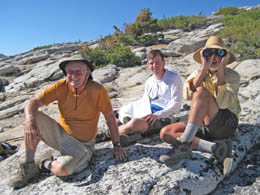
Pete, Scott and Fred on Vogelsang Pass |

View from Vogelsang Pass |

View from Vogelsang Pass |
After a little rest, Steve, Norma and I wandered down to a peaceful alpine lake that was just a half-mile behind the tents. The late afternoon sun on Vogelsang and Fletcher peaks was lovely. I watched a few band-tailed pigeons hanging out at the lake and a hawk overhead.
Sun is the spotlight
Shadow streaks on mountain peak
Hawk soaring above

Fletcher Peak (11408 ft.) from Fletcher Lake |

Vogelsang Peak - 11516 ft. |
The guys returned from their extra hike to Vogelsang Pass. We had a token cocktail gathering – finished off the last of our bottled spirits just in time for hot drinks followed by dinner.
The meals at all the camps have been outstanding, but Vogelsang surpassed them all. They have a legitimate Chef (with a long resume and professional aura) and our server, Justin, wore a funky 1970’s dinner jacket. The dinner was late – probably because the chef is picky. It started with a mushroom, onion, cilantro soup to die for followed by a huge Teriyaki Steak, veggies, rolls, salad, etc. Tonight we had a baked pear topped with berries and cream sauce – our first night without chocolate, but nobody complained. A funky rag-tag trio provide some after dinner music. The lead singer was pure Bohemian. I think they were visiting pals of one of the dishwashers.

Vogelsang Dining Hall and bathroom |

Vogelsang Camp |
After dinner, we had a campfire (without a fire – not allowed in Vogelsang). Adrianna took us out into a open field and pointed out Vogelsang and Fletcher peaks, the magnificent backdrop to our camp. Vogelsang is named after two German brothers claiming the peak was specifically named for them. Fletcher was once a park director. However, both the Vogelsangs and Mr. Fletcher had a hand in stocking the rivers with trout – not an ecologically smart thing to do, but the fish were a good source of protein for the miners at the time.
I just wish we had more time to explore this high alpine heaven with places with names like “Hanging Basket Lake.”
Right after the talk, we all gathered in Cabin #12 (Scott and Walt’s place) for a candlelight farewell gathering. We huddled on the beds and took turns presenting what we had written on a plain sheet of paper Adrianna had given us on the first day. Everyone was choked up and said the loveliest of things. It truly was a special time and a special group and with an amazing leader. We all had been forever changed by the experience. My presentation was at the end and I read some of my Hiking Haikus – Probably sucked the passion out of the group. They were all embracing each other while I chose to write about peeing in the woods. I need serious help!
Find a spot to pee
Squat behind a Lodgepole pine
Let the flood begin
Maybe I should have just read this one . . .
Green Yosemite
Seven grand days with open eyes
No words to describe
Norma and I rushed back to our tent after our good-bye session. Silly me walked into the tent exclaiming, “Who left the candle burning in here?” A woman (probably from Massachusetts), laying in her bed, sat up and said, “I did. You’re in the wrong tent.” I ran out laughing -- It’s not easy being goofy.
At 9:30, I found my way to Adrianna’s talk on the night sky. There she stood with an amazing green laser that she pointed at the constellations. She told us about the big bang, the Milky Way (our little galaxy) and the constellations. How does she do it? She pointed out that within the “bowl” part of the big dipper there are over 10,000 galaxies. I felt so overwhelmed, so insignificant and so brain dead. I couldn’t retain another fact, so I stumbled back to our tent.
It was getting chilly and Pete had a raging fire going in our potbelly stove to warm the place up. I’ll miss these guys.
Day 7
Sunday, July 22, 2007
Vogelsang to Tuolumne Meadows
8.5 miles / 1,700 feet elevation loss
Before breakfast, I took Bill to show him Fletcher Lake, near the camp. Bill got some glorious shots in that beautiful morning lights.

Last day in this amazing place |

Morning Beauty |

High alpine lake |

High alpine trail |
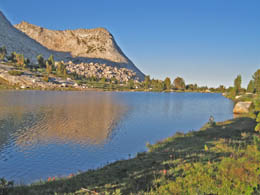
Can it get any more beautiful? |
 Morning light Morning light |

Indian Paintbrush |
After our final HUGE breakfast, we posed for our official group shot. All of us were sad to be leaving.
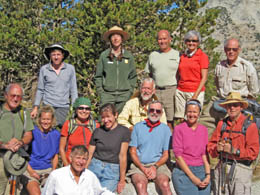
Official Group Shot |
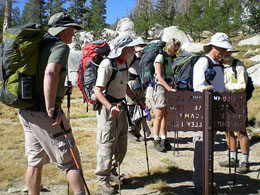
Packed up for our last day |
Sadly, we were going home today. We sang our final song to the Vogelsang staff.
Vogelsang Farewell Song -- by Walt Davie
Wish us luck as you wave us goodbye Cheerio, here we go on our way
Vogelsang, special place in the sky
Special crew, sing to you, It's our way
Give us a smile we can keep all the while
In our hearts while we're away
Till we meet once again, you and I
Wish us luck as we wave you goodbye!
|
Walt was our hero composer. In fact, Walt added another tune, just for fun. We’ll never forget him (or his fabulous music).
Walt’s Ode to Metamucil (a song he sings a lot)
Metamucil, metamucil
When you mix it with juce'll
Make you happy, no refusal
First, you get it in your tract
And then you give it time to act
And you will have a happy day
Oh, when you flush your cares away
Metamucil, metamucil
When you mix it up with juice'll
Make you happy, no refusal
If your condition makes you frown
And then you feel a little down
Take Metamucil for a week, for just a week
And you will function, cheek to cheek!
Metamucil, metamucil
When you mix it up with juice'll
Make you happy, no refusal
Then there's a rumble and a roar
And then you get results your'e waiting for
And without sorrow, stress or strain
There go your troubles down the drain, boom, boom, boom boom!
|
On our last day we hiked northward, descending a thousand feet and covering about 8 and a half miles on our way back to Tuolumne Meadows.
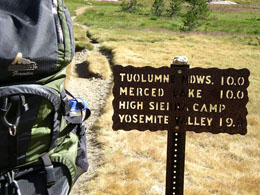
Sign says 10 miles, but our route was only 8.5
|
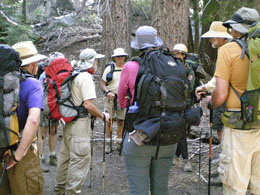
Listening to our leader |
We hiked through a quiet meadow descending gradually for a few miles. The meadow was especially lovely that morning, highlighted by swaying purple mist. Walking through it was surreal, like floating above the world. At the end of the meadow there were descending switchbacks with an occasional view of Tuolumne Meadows below.

Fields of Purple Mist |

Adrianna and the troops |
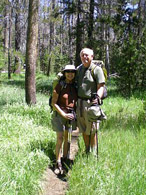
Pete and Norma -- Almost there |
Single blade of grass
Clustered, bundled shades of green
Meadow’s shag carpet
Adrianna stopped beneath an oak tree and told us how the Indians stored acorns in a cache to process and eat later. When the white man got serious about eliminating the tribes, they burned the caches, the Indian’s food source.
We watched while a busy Belding ground squirrel, with mouth stuffed with goodies, nervously waited for us to leave. When we vacated his property, he dashed down a hole to hide his goods.

Belding ground squirrel |
It was a warm day, but none of seemed to mind. In spite of the occasional fly, we were all just happy to be together.
Shoe hitchhiking fly
Why do you like my forearms?
Find another ride

High Meadow Trail |
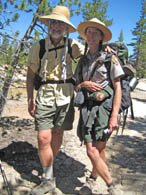
Fred and Adrianna |
Before we crossed the Lyell Fork of the Tuolumne River, we all sat down by the rushing river with Adrianna. I think she wanted to say her good-byes while we were still surrounded by nature’s beauty – not many dry eyes in the crowd. We didn’t want to leave this paradise and return to parking lots and freeways and life as we knew it.
Someone spotted an American-Dipper in the river walking along the edge of a mini waterfall, somehow clinging to the rocks in its search for food. We ran to take a picture. Norma said it was Dick’s (our comrade fallen by a broken leg the day before the hike began) dream to see an American Dipper. Norma was pleased to get a photo for Dick. Norma is like that – always thinking of others.
Adrianna asked that we walk in silence the rest of the way back to civilization (and the parking lot). It was a nice time to reflect on our wonderful adventure together. It end too soon and at 3-ish, we were back at Tuolumne Meadows Lodge, ordering beers and saying our last good-byes as we walked away.
Bonded with the group
High Sierra seven days
Scattered to the wind
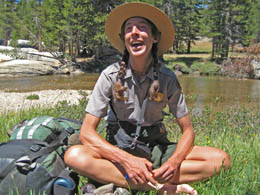
Our Adrianna |
ADRIANNA SONG, by Walt Davie
Off and away to Yosemite wide, with Adrianna our mentor and guide
Our boots kick up dust as we stay in her wake
Stopping only for snacks and pictures to take
The Flora and Fauna we find on the trail, nothing is missed, not even a snail
The campfire is rounded with knowledge of Muir
The depth is amazing, all coming from her
Our guide Adrianna is lithesome and lean
Take one look at her and you'll know what we mean
Her smile it is wide and her spirit is free
Sing Hail and Farewell to Anna Adri!
|
|











